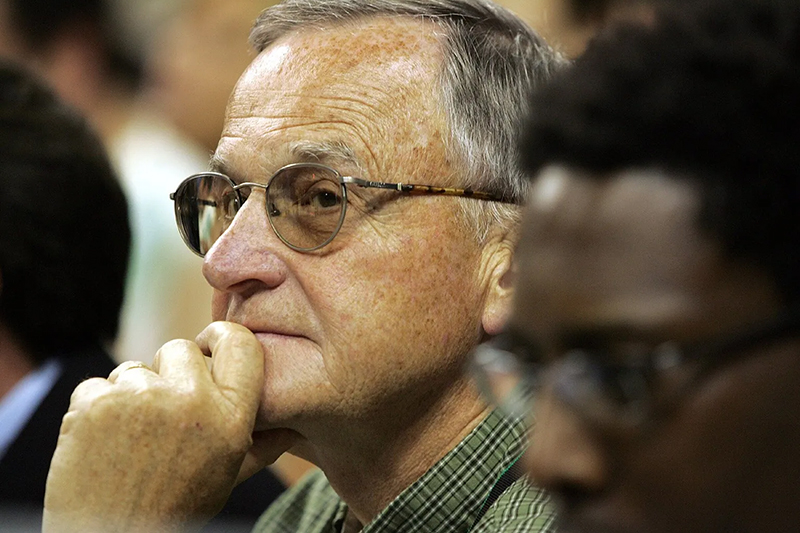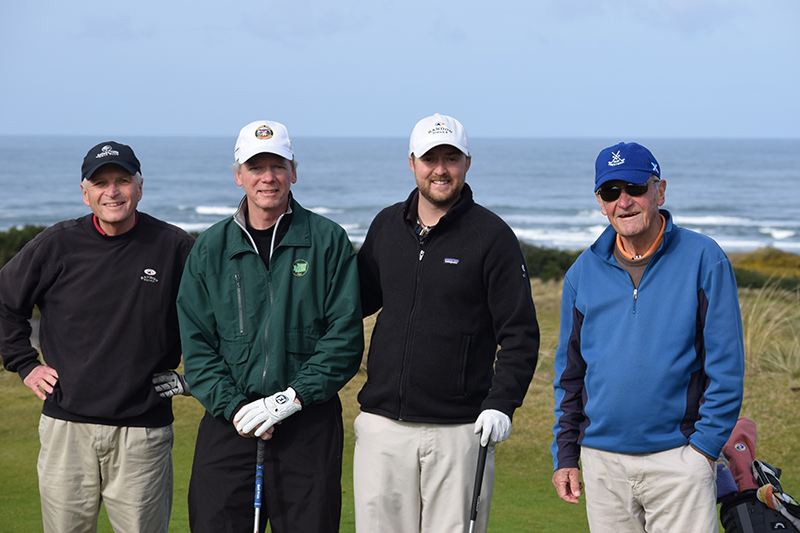Blaine Newnham, golf writer and former Seattle Times and R-G columnist, passes
by Geoff Baker
Former Seattle Times sports columnist Blaine Newnham understood that tracking down the biggest stories sometimes led you under the grandstands.

That’s where Newnham, then with The Register-Guard in Eugene, Ore., found star distance runner Steve Prefontaine hiding out just after he’d disappointingly finished fourth in a legendary 5,000-meter race won by Finnish rival Lasse Viren at the 1972 Munich Olympic Games.
Prefontaine had a standoffish relationship with the media and initially told Newnham he wasn’t talking. But after a round of consoling that disarmed the runner, Newnham told him both gently and firmly: “You owe it to the people of Eugene.”
The words struck, and Prefontaine, based for years in the emerging Oregon epicenter for U.S. track and field, shared his feelings with Newnham in a global exclusive. He confided about pressures of carrying a nation’s hopes and worries that he’d let his country down.
It was an early example of Newnham, who died peacefully late Sunday at age 82 in hospice care in Silverdale after a recent fall, putting athletes and coaches at ease with his thoughtful interviewing style. Also, of how he approached every story identifying what readers wanted, going out and getting it and then conveying it in the right words.
“He had his finger on the pulse of the fans,” said Dave Kayfes, who befriended Newnham while they were students at the University of California and later worked for him at The Register-Guard. “When he would cover a game, people would wait to see how he wrote it up. Because they’d seen the same game he did. And they knew he looked at it through their eyes. He was writing for them.”
Newnham had advocated for readers in college as well, resigning his position as sports editor of The Daily Californian student paper — along with other editorial staffers — in 1960 over a free speech clash. They alleged the Cal administration was deceiving student readers and wiping out free speech by censoring them from endorsing certain left-wing student group candidates.
The students even briefly set up and ran an alternative newspaper. Newnham then carried his concern for reader masses into his professional journalism career.
“You could say he was a ‘homer’ but he wasn’t,” Kayfes added. “He was writing for his readers. And he knew who was reading and the passion. So they looked for him when they got the paper.”
Newnham put The Register-Guard on a national stage in the 1970s as its sports editor and columnist before joining The Times from 1982 through his retirement in 2005. His storied career was all about pinpointing story angles and creative approaches to executing them.

Born in Alameda, Calif., near Oakland, Newnham became a cross-country runner for nearby Hayward High School and forged a longstanding passion for track and field. When not covering coach John Madden’s debut Raiders seasons for the Oakland Tribune, he chronicled present and future Olympians.
He worked the 1968 Olympic Games in Mexico City; seeing Bob Beamon’s historic long jump and sprinters Tommie Smith and John Carlos thrusting black-gloved fists in the air from the medal podium. He got to know Prefontaine in Eugene after arriving in 1971 to become The Register-Guard’s sports editor at age 29.
But Newnham also loved college sports, whether marveling at the 1991 Washington Huskies national championship football squad or an elusive University of Oregon running back from 20 years prior named Bobby Moore. When Moore, who later attained NFL and television fame after changing his name to Ahmad Rashad, set Oregon’s rushing record of 249 yards in a 1971 game against Utah, sports editor Newnham gathered his staff at Autzen Stadium to go over the coverage plan.
“He looked at us guys that were out there doing sidebars, and he said: ‘Why don’t one of you guys go and ask the Utah players what it was like trying to tackle Bobby Moore,’” said retired Times college basketball writer Bud Withers, who was then working at The Register-Guard. “Today it wouldn’t be revolutionary to think that way. But back then it was really forward thinking. It was more routine to just go grab stuff from your own coach and players. So it was an important thing that people weren’t really doing back then. And it was representative of how he thought about things.”
Newnham and his half-dozen Register-Guard staffers also forged innovation in story presentation. He and Pulitzer Prize-winning photo chief Brian Lanker redefined sports sections — going with large photos and limited cover stories while being among the nation’s first to employ color photography.
They also played hard together; office get-togethers outside of work were the norm. Newnham wanted everyone to feel they belonged. He introduced them to a “GOPPPL” game devised by a Raiders part-owner some Oakland football scribes had started playing and before long, “fantasy football” had a toehold in Oregon.
By 1976 The Register-Guard’s work was recognized by the Associated Press Sports Editors contest — naming it the nation’s No. 1 sports section, beating out much larger newspapers. The section remained in the APSE’s top three for the next five years before The Seattle Times hired Newnham as an associate editor in 1982.
Beyond sports, Newnham in Oregon had demonstrated news-reporting skills; breaking a 1975 story of an attempted tourism-related cover-up of a contaminated water source in Crater Lake that sickened more than 2,000 people over two months. While working in Portland at the Far West Classic men’s college basketball tournament in December 1978, he left to cover a United Airlines plane crash nearby that killed 10 people — managing to interview survivors from the flight.
But within months of arriving at The Times in his new executive news role, he’d returned to writing a regular sports column.
Newnham eventually helped lure some mainstays from his Register-Guard staff that formed the core of The Times’ sports section for years. One was Withers, who became one of the best college basketball writers in the country.
Another was Cathy Henkel, who arrived as an assistant sports editor and by 1990 became one of the nation’s first female sports editors — and the boss of her former boss, Newnham.
“He was known as an out-of-box thinker,” Henkel said. “The most creative mind I’ve met in the sports journalism world. He always had a new idea or way to draw reader in.”
Rick Lund, a former Times assistant sports editor and page designer, worked with Newnham for 20 years starting in 1985.
“When he spoke, people listened,” Lund said. “I sat in many sports planning meetings over the years, and no one brought more story ideas, more energy and more passion to the table than Blaine.
“I never worked with a person who had better instincts, or a better sense for what our readers wanted to read.”
Times colleagues remember Newnham excelling in his columnist coverage of Huskies college football and basketball games, breaking down the action in layman’s terms. His insights into football coach Don James were unparalleled. After the Huskies beat Oklahoma in the 1985 Orange Bowl, James gave Newnham exclusive details about his changes in offensive line blocking and other schematics that sealed the victory.
Newnham also expanded the paper’s rowing coverage, championing both men’s and women’s events. A 1986 column by Newnham bemoaning the dearth of high-level Huskies competition helped coaches Dick Erickson and Bob Ernst conceive the annual Windermere Cup races and regatta the following year. His 2004 column on surviving members of the Huskies’ men’s team and their gold medal at the 1936 Olympics in Berlin was published nearly a decade before the Daniel James Brown “The Boys in the Boat” book later turned into a Hollywood movie.
In keeping with his news instincts, he also wrote about the Second World War internment of Japanese American on Bainbridge Island where he lived.
After retiring in 2005, he remained a guest Sunday sports columnist for another year-plus before furthering his lifelong passion for golf. He first covered Ben Hogan at the U.S. Open in 1966. Then, for The Times, he covered Larry Mize winning the 1987 Masters with an incredible chip shot as well as four consecutive Tiger Woods major championship “Tiger Slam” victories in 2000 and 2001.
In retirement he played courses in Ireland and Scotland and helped launch the White Horse Golf Club in Kingston, remaining a loyal member the remainder of his life. He also co-wrote a book on the Chambers Bay golf course with Tom Cade titled “America’s St. Andrews” in 2014 ahead of it staging the U.S. Open the following year. He’d previously written a book about golf basics in 2003 and a jogging book decades prior about the “fad” he’d seen sprout up in 1970s Eugene.
Part of Newnham’s life approach extended from his 1970s coverage of distance runner Prefontaine, who’d done so much in short order and always striven for more. The night of Prefontaine’s fourth-place finish in Munich in 1972, he’d vowed to Newnham he’d return even stronger at the 1976 Olympics in Montreal.
But Prefontaine never got there, killed in a 1975 car crash at age 24. The next day, Newnham closed a column on Prefontaine’s death with a line summing up the runner’s legacy: “Run for first. Don’t even think about second or third.”
And former Register-Guard colleague and college buddy Kayfes, who still lives in Eugene, said Newnham’s similar efforts in his chosen field were never forgotten.
“He’s still revered down here in the track world,” Kayfes said. “He’ll always be a legend down here. He put together coverage that hasn’t been duplicated.”
Newnham, a longtime Indianola, Wash., resident who spent his final years on Bainbridge Island, is survived by his wife of nearly 60 years, Joanna Lindeman Newnham; his daughters, Nicole (son-in-law Tom Malarkey) and Lisa; his son, Daniel and daughter-in-law Linda Newnham; and four grandsons, Josef, Finian, Blaine and Hudson.
A memorial and celebration of life is planned for later this summer on Bainbridge Island.
Geoff Baker covers hockey and is a sports enterprise and investigative reporter for The Seattle Times. [email protected]
(This article first appeared at SeattleTimes.com. Used here by permission.)





